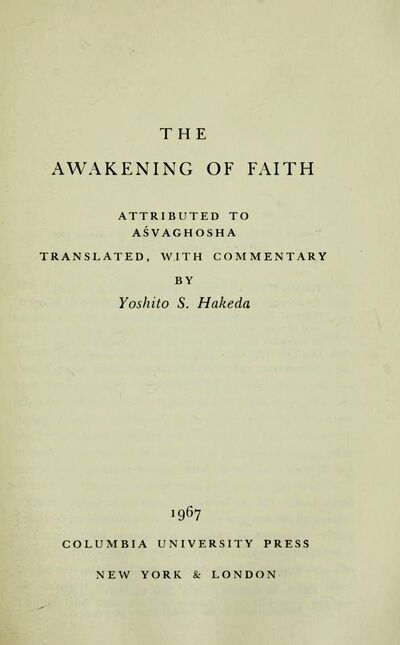- Foreword, by Wm. Theodore de Baryv
- Prefacevii
- Introduction1
- The Awakening of Faith21
- Invocation23
- The Contents of the Discourse24
- Part 1 The Reasons for Writing25
- Part 2 Outline28
- Part 3 Interpretation31
- Chapter One: Revelation of True Meaning31
- I. One Mind and Its Two Aspects31
- A. The Mind in Terms of the Absolute32
- 1. Truly Empty34
- 2. Truly Nonempty35
- B. The Mind in Terms of Phenomena36
- 1. The Storehouse Consciousness36
- a. The Aspect of Enlightenment37
- (1) Original Enlightenment37
- (2) The Process of Actualization of Enlightenment38
- (a) Purity of Wisdom41
- (b) Suprarational Functions41
- (3) The Characteristics of the Essence of Enlightenment42
- b. The Aspect of Nonenlightenment43
- c. The Relationships Between Enlightenment and Nonenlightenment45
- (1) Identity45
- (2) Nonidentity46
- a. The Aspect of Enlightenment37
- 2. The Cause and Conditions of Man’s Being in Samsara46
- a. Mind47
- b. Consciousness49
- c. Defiled States of Mind51
- d. Comments on the Terms Used in the Foregoing Discussion52
- 3. The Characteristics of Beings in Samsara54
- a. Permeation of Ignorance56
- b. Permeation of Suchness58
- (1) Permeation Through Manifestation of the Essence of Suchness59
- (2) Permeation Through Influences61
- (a) The Specific Coordinating Causes61
- (b) The General Coordinating Causes63
- 1. The Storehouse Consciousness36
- A. The Mind in Terms of the Absolute32
- II. The Essence Itself and the Attributes of Suchness, or The Meanings of Mahā64
- A. The Greatness of the Essence of Suchness64
- B. The Greatness of the Attributes of Suchness65
- C. The Greatness of the Influences of Suchness67
- III. From Samsara to Nirvana72
- I. One Mind and Its Two Aspects31
- Chapter One: Revelation of True Meaning31
- Chapter Two: The Correction of Evil Attachments73
- I. The Biased Views Held by Ordinary Men74
- II. The Biased Views Held by the Hinayanists78
- Chapter Two: The Correction of Evil Attachments73
- Chapter Three: Analysis of the Types of Aspiration for Enlightenment, or The Meanings of Yāna80
- I. The Aspiration for Enlightenment Through the Perfection of Faith80
- II. The Aspiration for Enlightenment Through Understanding and Deeds86
- III. The Aspiration for Enlightenment Through Insight87
- Chapter Three: Analysis of the Types of Aspiration for Enlightenment, or The Meanings of Yāna80
- Part 4 On Faith and Practice92
- On Four Faiths92
- On Five Practices93
- The Practice of Cessation96
- The Practice of Clear Observation100
- Part 5 Encouragement of Practice and the Benefits Thereof103
- Notes105
- A Selected Bibliography119
- Index123

